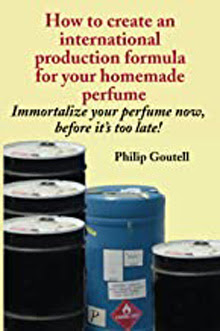If you are serious about making (serious) perfume, your first item of business is to set up a permanent notebook in which ALL of your formulas, ALL of your trials, will be recorded methodically.
This fact of life was brought home to me vividly the other day when I started work on some solid perfumes I was developing for low cost samples of my regular fragrances. I wanted to use the original compounds without the alcohol having been added and discovered I was OUT OF STOCK on several compounds. I would have to make more. Fine. No problem. I'll go to my notebook and retrieve the formulas. Yes, I found (most) of what I was looking for, but it should have been easier.
Before I go into my own record keeping, which now spans quite a number of years, let me review what is needed in those records when you come back to a formula after an absence.
First of all, you need a list of the materials you've used in your formula. And you have to identify those materials VERY PRECISELY. This means the vendor's full name and item number for that material, and the date on which it was purchased. The point is that you want to be able to go back to that same vendor and order, by item number, that same item.
Date can help you, especially when ordering a natural material such as an essential oil as these are subject to annual variations due to weather and soil conditions. Before you make use of a new order of a natural, use your nose to check it for variance from your original. And remember, natural materials tend to have a limited shelf life.
Next, you need to record the QUANTITY used for each material in your formula. If you, like me, make your trials and formulas using dropper bottles, you know your accuracy will not be precise. Don't let this discourage you. What I do is develop a formula using dropper bottles, measuring out drops, half-drops (running a little material down the side of a toothpick), and tiny fractions of drops (by dipping a clear toothpick first into the aroma material and then swirling it around in my mixing pot).
I work with drops because it's simple and my nose isn't well enough trained to spot the (small) differences in the batches that are mixed this way. Also, because it typically takes me many trials to come up with the winning formula, I would go broke using larger quantities of raw materials during the development stage, particularly when I'm using some costly natural materials.
To go from "formula by drops" to production formula, it's necessary to convert these drops into grams. This requires a scale (an electronic balance that will read to two or three decimal places) and multiplying your "drops" formula by some number that will increase the volume of the compound you are producing to the point where you can have confidence that the gram measurements will be accurate.
Typically I'll multiply my "drops" by five or ten and them, using the dropper bottles and scale, produce this slightly larger batch of the formula on the scale, recoding now the weight of each material added. When I'm finished I now have the formula converted to grams.
For production I'll go one step farther. I'll convert the grams to percentages. The whole formula will be 100 percent and now, knowing what percentage each material will be, I can work backwards from the quantity (weight) I want to produce and write out the required weight of each of my materials.
Finally, your notebook should clearly identify which of your trials is the FINISHED VERSION of your fragrance.
When I am developing a fragrance I use codes for each trial. Usually these are based on pages from my notebook. Even when I think I'm finished, that I've found what I'm looking for, I may continue to test and so the SELECTED formula is not necessarily the last formula in the sequence of tests.
So it's important to mark your selected version, the version of the formula that you are putting into production, with the NAME you have given the fragrance or some similar designation so you can accurately match the fragrance you are selling with its precise formula.
Personally I keep a bound notebook for recording the many versions of my formulas as they are being developed. I have been known to abbreviate the names of raw materials, thinking the vendor and precise designation will be embedded in my brain forever. This can cause grief when, five years later, I'm only 85 percent sure that I've interpreted the name, item number, and source of the raw materials correctly.
With time, the number of my notebooks has grown. At times I'm working here in the USA but in the summer I'll be in Canada and I drag along a lot of notebooks and sometimes, during the summer, write formulas in a new notebook which can be misplaced upon my return to the USA. So sometimes I have to hunt (too much!) for a formula that should be at my fingertips.
If you like digital
Regardless of all these physical notebooks, which are often a quick way to enter trial after trial, when I get seriously near to my final result or when I reach my final result, I transfer my data to the computer using The Perfumer's Workbook, a neat piece of fragrance development software from PerfumersWorld. You can read more about it here.
And those solid perfume samplers ... if you're interested, you'll find them among the products advertised here.
Wednesday, February 20, 2013
Subscribe to:
Post Comments (Atom)


No comments:
Post a Comment